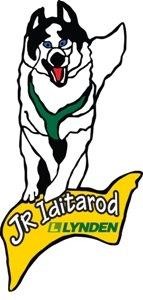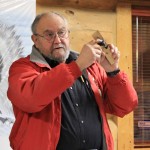Junior Iditarod Rookies gathered at Iditarod Headquarters in Wasilla for their Rookie Meeting on Thursday evening prior to the race. A variety of presenters talked about every thing from dog care to ski poles.
As has been a tradition for many Junior Iditarod Rookie meetings, Dr. Jayne Hempstead discussed dog care. She emphasized that winning is a lot more than crossing the finish line first – know what you’re doing and take excellent care of your dogs. She also focused on the mushers caring for themselves – take care of yourself so you can take care of your dogs. When you snack your dogs, snack yourself but the most important snack for the musher comes about 45 minutes out from the checkpoint. Dr. Jayne gave specific tips on booting, hydration, visibility and several other dog related health issues. In conclusion she encouraged the teens to know your dogs and their needs and be prepared to meet them. Success equals crossing the finish line with happy healthy dogs that are ready and able to continue.
Danny Seavey challenged the young mushers to know your dogs and control your speed the first half of the race, especially the first few miles. Determine the right speed for your dogs and create your plan. Seavey offered the rookies an incentive in the form of a $50 gift card for the team that had the flattest time (closest outbound in inbound times). Seavey also offered some advice on when to decide if a dog should be dropped. Decide going into the checkpoint. If a dog doesn’t look good going into a checkpoint then it should be dropped before leaving. Another piece of advice shared by Danny, “Your emotions count a lot. If you’re stressed, your dogs know it. Do what you always do. Don’t change anything for the race.”
Former sprint racer, Jim Uhl, helped the juniors establish their race many years back. Before offered any tips on sled repair, Jim complimented the rookie mushers on having their act together. Sled repair kits that originated through Bernie Willis were given to each of the rookies. Jim went through the contents of the repair kit that contained everything from hose clamps to dental floss.
Larisa Myers-McCoin, current Junior Iditarod Board member and former Junior Iditarod contestant shared information on snacking dogs. When choosing snacks, fish has more water content than beef or chicken. She suggests cutting snacks into small pieces as it takes less energy to consume.
The rookies heard from mother and daughter team Marilyn and Meredith Mapes. Marilyn has spent many junior races as trail breaker and Meredith is a race veteran. Marilyn talked about dressing and what items one should have in their first aid kit. Meredith talked about the Denali Highway run out to Alpine Creek Lodge. Things to remember for the juniors – look at the labels and avoid cotton in all garments and dress in layers. Meredith encouraged the use of ski poles and to be prepared for some long hills. Expect sun so be prepared with sunglasses or goggles. Meredith stressed how deceptive the term highway can be – sounds like a road, sounds like an easy run. The road is in the open and very susceptible to drifting. The last eleven miles to Alpine Creek Lodge is a steady uphill climb. Don’t let the term highway fool you. The run will be plenty challenging.
- Danny Seavey makes a point
- Jim Uhl on Sled Repair
- Marilyn says, “Cotton is rotten.”
Finally, trail boss, Richard Plack, explained the trail markings. The typical orange topped lath trail marker will be placed along the trail, 3 or 4 stakes for every mile. As you pass one you’ll be able to see the next. The mile markers along the highway can also be considered markers. Plack assured the kids, “This being a road, it’ll be fairly simple to find your way.” The road isn’t maintained for vehicle traffic in the winter but it’s a popular snowmachine route and sled dog training trail.




